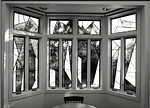Book Ends: COMMEMORATIVES TO TWO INFLUENTIAL LIBRARIANS
Beatrice Agnew, former librarian of the Palisades Free Library, and Mary Berhringer, former librarian of the Blauvelt Free Library, were good friends in life. Although they are no longer with us, I have recently forged a different sort of connection between them: stained glass windows.
The windows in the Palisades Free Library, done in Beatriceʼs memory with the theme of books, were viewed by the Board of Trustees from Blauvelt. Shortly after, I was invited to design windows in honor of Mary Berhringerʼs forty eight years as Director, a position she held longer than anyone in New York State.
The invitation was accepted with pleasure. After reviewing all the possibilities, I chose the twelve bay windows in the libraryʼs Mary Berhringer wing as the best place to install her memorial, echoing the placement of Beatriceʼs bay windows in Palisades.
One of the interesting parts of designing is finding a relevant theme. I had met Mary only once. Despite her ninety four years, her feisty personality was completely evident. Mary had been the director for most of the second part of the 20th century when libraries held books as most of us know books, and into the digital age, with the advent of computers and ebooks. Despite Maryʼs training and age, she was a woman of our time, unafraid to take risks with new technology. I decided transformation would be my theme.
My next task was to find a design metaphor working within the limitations of the bay windows, the size and shape of the room and the southerly light. Southerly light in wintertime can cause glare as the sun is lower in the sky than in other seasons.
What came to mind were crystals. They grow, have beautiful shapes and not all are symmetrical. The colors are wonderful. I loved the idea a person can grow crystals from simple matter like salt and sugar. And so I planned to transform these ideas into stained glass using simple and complex forms, by capturing light and giving it shape and beauty.
Recently I have been working with the Rohlf Stained Glass Studio located in Mt Vernon, N.Y. They take careful measurements, and if they havenʼt got the mouth-blown glass I require for a project, will order it. The best studios remind one of the middle ages, when this painstaking craft reached its height.
Once the Board approved my design, I drew full scale cartoons at my Lawrence Lane studio and delivered them to the Rohlf Studio for fabrication. The cartoons were placed on large pieces of carbon paper layered between two rolls of heavy brown paper. One copy would be used for the paper patterns and the other to display the glass after it had been selected and numbered. The paper patterns were cut with special shears omitting the traced line to leave space for the heart of the lead.
A clear glass 1/4 inch easel was placed over the original cartoons and the lead lines traced on this glass with opaque black paint. Then the easel was placed against a huge glass window as I selected each piece of glass for texture and color. The glazier worked with me in an improvised rhythm and used beeswax to adhere my glass selections to the easel. When all was complete, each piece of glass, cleaned of wax, was put on the table over the line drawing in preparation for glazing. Leads were stretched and stiffened, put in place and soldered, reinforcing bars applied, and the panels puttied and cleaned with whiting.
When selecting glass before natural light, it is important to consider what exists outside the windows. Are we looking at a blue sky with moving white clouds, a red brick wall or trees with foliage, or trees with snow? Of great importance is the quality of light as its determined by the direction the windows face. It all makes a difference in the appearance of the glass. Texture, transparency, translucence and ambient light are part of the equation. I also took into consideration the lead width, the putty, the cleaning, and the protective glass. The reinforcing bars, scaffolds for installation, personalities of workers and, in this case, just plain Life and Death all added up to a challenging adventure.
I wish Iʼd spent more time with Mary. She was not to live long enough to see the windows completed, but I like to think she and Beatrice remain connected to us and to each other through them.
Harriet completed the windows immediately following the death of her husband, Charles, after a long illness, and the windows were installed a few weeks later. To view other works by Harriet, go to harriethyams.com Photo: ERIC VORENKAMP


